Antares reports from the 1998 ‘Rainforest World Music Festival’ in Sarawak
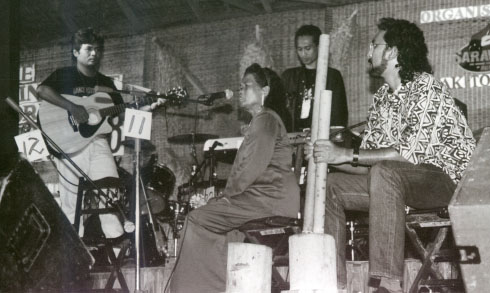
MAK MINAH strolled along the white sands, her
hunter-gatherer eyes scanning the beach for little sea crabs and edible
molluscs. She glanced up at the luminous clouds clinging to the evocative
peak of Mount Santubong. So this was the Land of Hornbills. Beautiful,
postcard views - but not a single hornbill in sight.
A few hours earlier, the 68-year-old
Temuan ceremonial singer had boarded a Boeing 737 jet at the cyclopean
KLIA for the brief, bumpy flight to Kuching. Her first ever airborne experience.
As usual, Mak Minah was amazingly cool about it: “No big deal,” was her
verdict. However, she had prepared herself for the big gig “overseas” -
at Sarawak’s First Annual ‘Rainforest World Music Festival’ - by getting
her hair permed a whole fortnight before the event.
When Dr Wan Zawawi (songwriter-anthropologist
who’s now Dean of the Faculty of Applied and Creative Arts at UNIMAS) invited
Akar Umbi to join his Anak Dayung group for this two-day “World Music”
festival (August 29-30, 1998), I didn’t have a clue what he was talking
about. “Back me up on a couple of numbers and you get to perform one of
Mak Minah’s songs,” the affable academician had said. Well, I’d never been
to Sarawak, and this promised to be an idyllic musical junket. Now, we
only needed to check if Rafique was game for this gig. Miraculously, he
was, even though the monetary stipend was modest. As it turned out, we
were rewarded with four memorable nights in a musician’s heaven.
I didn’t know who else was
on the festival bill until we received our souvenir programmes. The only
name familiar to me was Joey Ayala, whom I’d met 13 years ago at
the first Kuala Lumpur Arts Festival. It was a blast to see Joey Ayala
again, accompanied by his immensely lovable and vivacious band. When
I finally saw them in action, Joey and his dazzling group simply blew me
away.
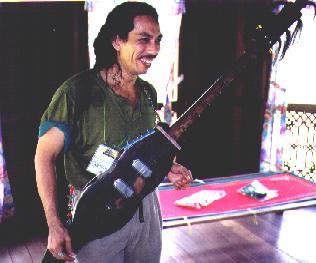 “O mighty eagle, my true king, I want to fly in the sky like you,” Joey
Ayala intoned, lamenting the plight of latter-day eagles who - not finding
any more tall trees to build their nests - were in captivity, or in hiding,
wings folded and flightless. “May there always be tall trees in the forest
for us to build our nests, so that like the mighty eagle, we too can fly.”
Eagles, hornbills, emblems of freedom and nobility.
“O mighty eagle, my true king, I want to fly in the sky like you,” Joey
Ayala intoned, lamenting the plight of latter-day eagles who - not finding
any more tall trees to build their nests - were in captivity, or in hiding,
wings folded and flightless. “May there always be tall trees in the forest
for us to build our nests, so that like the mighty eagle, we too can fly.”
Eagles, hornbills, emblems of freedom and nobility.
For an instant a small frown
furrowed Joey’s brow. Then he called out to the sound booth: “NO SOUND!
I want to play my guitar!” (Yes, there were LOTS of problems with the sound,
mainly due to the understandable confusion of a technical crew who had
never experienced a concert of this scale and variety.)
And there was sound. What a monstrously
beautiful, powerful, towering, ecstatically transcendental sound - earthy
as a Filipino folk tune, funky and spunky as celestial angel come. No one
embodied the spirit of the Rainforest World Music Festival more musically,
more poetically, more sincerely than Joey Ayala. And when his band let
rip, everyone just soared like an eagle - or a hornbill - riding the joyful
musical airstreams.
Joey’s line-up? Cynthia Alexander
(Joey’s “baby sister”) on electrifying bass guitar, an impish, science-fiction
elf-princess, flying sorceress, and a highly gifted award-winning musician
to boot. Malou Matute, wholesome piano teacher turned diabolical percussionist
(she played gamelan-like tuned gongs called kulintang). Renato Tengasantos,
dynamic powerhouse on a runaway drum kit (it took two stagehands to hold
down his bass drum!); Alex De Paz Tupaz on exotic “marimba tree” (for want
of an actual name); Francis Reyes on highly effective “effects” guitar;
and Joey Ayala himself, switching from rhythm to lead guitar, to a lizard-like
two-stringed beast called a hegalong that spewed forth smouldering, soul-satisfying
riffs.
Take the down-to-earth, folksy
approachability of Country Joe and the Fish... throw in the mesmerizing,
messianic charisma of Bob Marley... add a dash of Frank Zappa’s wizardly
wit and musical competence... serve with a generous dollop of Pink
Floydian rock concert theatricality... and you have the Joey Ayala group!
We found ourselves swept away by the typhoon of pure musical excitement
they unleashed. Rafique shared my view that this was the absolute high
point of the festival. And, judging by the eager mob that swarmed around
Joey and his group after their performance, almost everyone else thought
so too.
True, the Celtic jazz quartet,
Lammas
(flown
in by the British Council) served up a stimulatingly virtuoso performance
- salvaging the first night from being generally lacklustre - but it was
Joey Ayala on the second night who captured the heart of Puteri Santubong
(legendary princess of the mountain, whose story no one would relate to
me, because it was too complicated or too tragic). I’m sure Joey’s inspiring
performance made the Spirit of the Sacred Mountain smile and weep for joy.
Lammas delivers a heady fusion
of intelligent, progressive jazz, flavoured with Irish, Scottish, and Portuguese
folk melodies. Co-founded by Don Paterson (on guitar and bodhrán)
and Tim Garland (on concert flute and saxophones), the Lammas sound was
exquisitely augmented by Karen Street on accordion, whose sensitive colouring
turned her instrument into a synthesizer, fiddle, bagpipes - in a performance
that was both an epiphany and a revelation. The husky allure of vocalist
Christine Tobin’s pitch-perfect and soulful voice was at once earthy and
heavenly (everyone fell instantly in love with her, or at least, I did).
Garland and Paterson write (or arrange) much of the Lammas material: intricate
pieces of invigorating originality and verve, performable only by master-class
musicians. As a guitarist, Don Paterson is a worthy successor to fellow
Scotsman John McLaughlin; while Tim Garland is technically on par with
Jan Garbarek, the great Norwegian blower he so admires.
B’tutta - a Sydney-based, conservatorium-trained,
highly cerebral percussion combo consisting of Graham Hilgendorf, David
Hewitt, Cameron Gregory and Leigh Giles - put on a pyrotechnic display
of precision teamwork on an impressive array of tuned and untuned instruments
(e.g., marimba, xylophone, handsaw, open plastic canister in a tub of water,
and so on).
The boys’ energy and enthusiasm
were infectious, but as the set wore on - and the music stayed strictly
above the waist, never venturing into the visceral and scrotal zones, even
when they were impersonating a Caribbean steel-drum band - their cleverness
began to irk a little. At times B’tutta (meaning “to strike” in Italian)
came across as a somewhat Beatle-ish bunch of factory workers, banging
about on idle machinery just to amuse themselves in the absence of the
supervisor. There might have been some serious dancing in the aisles or
on the lawn under that hot, sultry, starry night sky - if only B’tutta
had loosened up and let fly.
The first night’s programme also featured Safar Ghaffar, a singing, dancing, pop shaman from Kuching (with the fashion designer’s flair for style over substance); the fresh-faced, chirpy-toned and utterly innocuous BM Boys (a best-selling Chinese vocal group presumably from Bukit Mertajam, near Penang, who struck a resonant chord with the Mandarin-speaking section of the crowd); Andrewson Ngalai (a big-time Iban pop crooner with “fourteen albums to his credit” who really captivated Mak Minah’s romantic, rustic soul); Electro-Acoustic Group UNIMAS (comprising students and lecturers from the Universiti Malaysia Sarawak’s Faculty of Applied and Creative Arts); a Bidayuh Group, Sape Ulu, and Voice of the Usun Apau (representing Sarawak’s Bidayuh, Kenyah, and Penan tribes). Much as I would have liked to sample the tribal offerings slotted early in the evening’s schedule, they were over and done with by the time we arrived at the Sarawak Cultural Village, venue of the Rainforest World Music Festival - whose patron, the Sarawak Tourism Board, organizing committee, and consultant Randy Raine-Reusch, deserve a huge round of applause for a job very well done.
Excitement fairly crackled on the second night
- from my perspective, not least 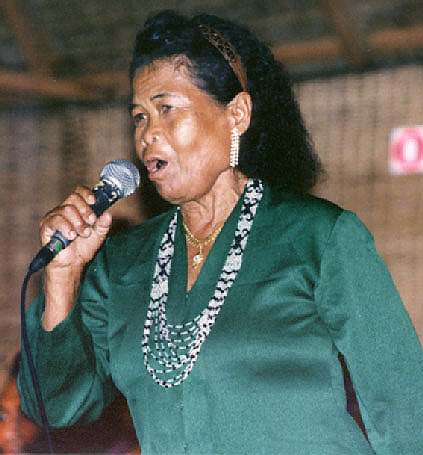 because Akar Umbi was scheduled to perform with Dr Wan Zawawi’s Anak
Dayung group. But around noon that same day, Rafique and I had been
roped into backing Zuriani - with approximately 44 minutes to learn
and rehearse two of her songs, Alhamdulillah and Candle Dance.
And we’d only just met, at dinner two evenings ago!
because Akar Umbi was scheduled to perform with Dr Wan Zawawi’s Anak
Dayung group. But around noon that same day, Rafique and I had been
roped into backing Zuriani - with approximately 44 minutes to learn
and rehearse two of her songs, Alhamdulillah and Candle Dance.
And we’d only just met, at dinner two evenings ago!
Well, we had two other last-minute
recruits: Anak Dayung’s trusty gambus and tabla player, Yahya Ibrahim (on
loan from the Army Band, Orkes Tentera Darat), and Johari Morshidi, a spirited
gendang player with Tuku ‘Kame’
(the Sarawak Cultural Village’s
resident “ethnic fusion” orchestra led by flautist Narawi Hj Rashidi; Tuku
Kame’s star asset, however, appears to be Jerry Kamit, Jeff Beck of the
electrified sape and a thoroughly urbane young Iban).
Wait, make that THREE daredevil
recruits: adorable Ainal, Johari’s nine-year-old true-blue trooper son,
was game enough to back us up on auxiliary percussion. And what a natural-born
show-stopper young Ainal turned out to be!
Now, you may ask: who is Zuriani
Khalid? And rightly so, for this enchanting and talented singer, songwriter,
record producer, and multi-instrumentalist has been living and working
in the U.S. for the last 16 years. Within months of her return to Malaysia,
Zuriani was busy producing big-name local artists like Siti Nurhaliza,
Ella, Ziana Zain, Fauziah Latiff, Farra and KOOL.
“It’s been two years since
my last public performance,” Zuriani confessed. “And I don’t want to make
a complete fool of myself.” The symphonic orchestral backing she had earlier
envisaged for her songs wasn’t working out. Zuriani felt that a smaller,
tighter back-up group might just about pull through, if she did only two
numbers instead of six.
I guess we all need anecdotes
that can be passed on to our grandchildren. The night of dangerous living.
We got on stage, checked out the mikes... Zuriani glided confidently to
stage centre as the emcee introduced her. And it went down like ice cream
on a hot day. The audience loved Zuriani. We all loved Zuriani, the Queen
of Malaysia’s nascent World Music Scene!
(This little incident precipitated
a two-day sulk from another Queen: Mak Minah was somewhat miffed that her
two musical Knights Errant were publicly championing another diva,
and refused to talk with Rafique and me until we were airborne on the flight
home.)
As it turned out, Mak Minah
stole the show as soon as she began belting out
Hutan Manao (a big
hit when she first performed it four years ago at the Shah Alam Stadium).
And when she did the joget with Wan Zawawi during the instrumental breaks,
the crowd went wild. Young men rushed the stage showering her with flowers
plucked from nearby shrubbery. Cameras flashed and whirred furiously throughout
the Akar Umbi number.
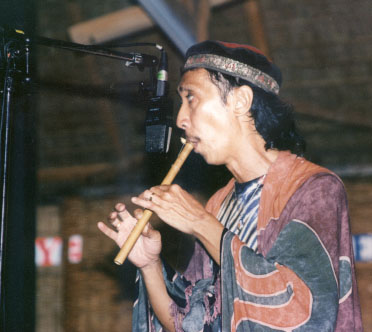 Fortunately, Wan Zawawi’s two songs from his debut Dayung album were very
warmly received - including the spontaneous “hologram video clip” I inserted
in the middle of Mencari Amerika when, after prancing sweatily around
for a couple of minutes, I was inspired to sniff my armpits and announce
the “New World Odour.”
Fortunately, Wan Zawawi’s two songs from his debut Dayung album were very
warmly received - including the spontaneous “hologram video clip” I inserted
in the middle of Mencari Amerika when, after prancing sweatily around
for a couple of minutes, I was inspired to sniff my armpits and announce
the “New World Odour.”
The Nuradee Brothers’ Kuching
fan club let out a roar of appreciation when Wan gave over the stage to
these phenomenal singing siblings from Singapore. Their hit Diam (“Silence”)
met with noisy applause. After the set everyone was grinning broadly, especially
Ken Linang - a soulful blues guitarist unearthed in Kuching by our anthropologist
friend and concert facilitator, good old Dr Wan.
Earlier I had been absolutely
enthralled by Badan Budaya Melanau and the powerful, ritual trance
dance performed by their shaman. I was told by some locals that this was
indeed a rare treat, to be witnessing an authentic Melanau ritual on a
concert stage. As the ancient-sounding “court orchestra” played, I was
transported back a thousand years to Angkor Wat in Cambodia, Bali in Indonesia,
Pagan in Burma, and Palenque in Central America... then the shaman entered
deeper into his trance and began stomping on bits of broken ceramic. The
musicians seemed really charged by the ritual. The Badan Budaya Melanau
troupe even had “special helpers” on standby, just in case the shaman failed
to emerge from his trance in the time allotted!
The MIA Traditional Orchestra
(in this instance, MIA stands for “Malaysian Institute of Art” - NOT “Missing
In Action”!) performed a scientific synthesis of Asian and European chamber
music arranged by ace flautist Yii Kah Hoe. Adventurously combining the
sounds of the Sarawakian
sape with the Malay rebana and serunai;
and the Chinese pipa
and
dize
with the more familiar cello,
saxophone, violin and piano, the hardworking ensemble impressed with their
meticulous discipline. Even a 3-minute blackout in the middle of their
set failed to deter them from completing their performance with a flourish.
The MIA contingent was extremely diligent in recording audio samples and
making detailed notes all throughout the afternoon workshops held in conjunction
with the festival. So the outing for them was also a field research expedition!
While waiting to go on, I
was able to catch only snatches of various other performances like the
UNIMAS
Gamelan Group and the Kumpulan Gendang Melayu Asli. The Sarawak
Cultural Village seems to have become the unnatural habitat of traditional
groups who now earn their keep playing to tourist audiences. While their
musicianship remains at a high level, one cannot help but sense that for
many of these players, music is now essentially just a job.
ASZA, a crafty and
inventive Vancouver-based acoustic quartet, was the last 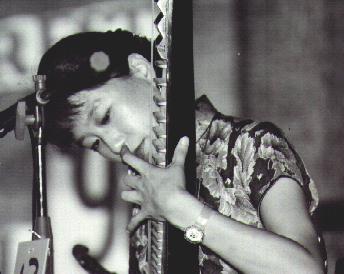 featured act on the festival bill. With Qiu Xia He (pronounced “Chu-sha”),
a Chinese
pipa virtuoso lending her Oriental charm and grace and
consummate skill; Uruguayan percussionist extraordinaire, Joseph “Pepe”
Danza, contributing his wild Latin exuberance and wonderful rhythm; Quebecois
flamenco-jazz ace guitarist Andre Thibault adding a stylish dash of Gallic
flair, passion and humour; and master musician and multi-instrumentalist,
Randy Raine-Reusch (who claims aristocratic Flemish descent) providing
the musical navigation and networking - ASZA is the quintessential,
multi-ethnic embodiment of World Music, which Randy defines as “the music
of, or resulting from traditional or indigenous cultures.”
featured act on the festival bill. With Qiu Xia He (pronounced “Chu-sha”),
a Chinese
pipa virtuoso lending her Oriental charm and grace and
consummate skill; Uruguayan percussionist extraordinaire, Joseph “Pepe”
Danza, contributing his wild Latin exuberance and wonderful rhythm; Quebecois
flamenco-jazz ace guitarist Andre Thibault adding a stylish dash of Gallic
flair, passion and humour; and master musician and multi-instrumentalist,
Randy Raine-Reusch (who claims aristocratic Flemish descent) providing
the musical navigation and networking - ASZA is the quintessential,
multi-ethnic embodiment of World Music, which Randy defines as “the music
of, or resulting from traditional or indigenous cultures.”
“Which means that World Music
is not a new musical genre,” Randy points out in his programme notes as
Festival Consultant, “but one as old as humanity itself. Yet World Music
CDs have been outselling Rock, Classical and Jazz CDs in the West for a
number of years, and this trend is now starting to appear in Asia.”
Randy is an old hand in the
music business with heavy-duty connections to a wide selection of top players
around the world. As a musician he has “been there, done that” - and now
delights in his precious collection of weird musical instruments. “Between
Pepe and me, we have over 700 instruments in our warehouse,” Randy says
matter-of-factly. (His collection of personal anecdotes is equally
impressive: “John Cage cooked lunch for me two days before he died.”)
What about ASZA’s music? Well,
I thought they were a perfect music festival item. The group offers a very
palatable mix of musical innovation with occasional displays of superb
musicianship, a mature theatrical sense, an easygoing, humorous rapport
with their audience, and the ASZA sound is guaranteed to stimulate the
most stultified musical imagination. It was great to hear the Canadian
group “ASZA-fy” a well-known Dayak ditty. During the intro, Randy bowed
his sape like a viola to delightful effect, inspiring fresh options for
contemporary as well as traditional musicians.
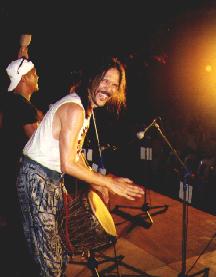 When it came time for the Grand Finale, all the performers were invited
on stage for an impromptu jam session conducted by “Pepe” Danza. Usually,
these are somewhat cacophonous affairs, but so high and happy was the entire
ensemble that, for over twenty minutes, everyone played and sang in perfect,
magical harmony. Even the solemn-faced Melanau drummers were grinning,
and the shaman flashed me a small, knowing smile when our eyes fleetingly
connected.
When it came time for the Grand Finale, all the performers were invited
on stage for an impromptu jam session conducted by “Pepe” Danza. Usually,
these are somewhat cacophonous affairs, but so high and happy was the entire
ensemble that, for over twenty minutes, everyone played and sang in perfect,
magical harmony. Even the solemn-faced Melanau drummers were grinning,
and the shaman flashed me a small, knowing smile when our eyes fleetingly
connected.
And, midway through the finale,
we all did a countdown for Merdeka. Never has the word “freedom” rung truer
than on that unforgettable night, when performers and audience joined their
spirits in uninhibited, euphoric celebration, under the ancient and benign
gaze of Mount Santubong.
(An abridged version of this article was published in the November 1998 issue of Men's Review)